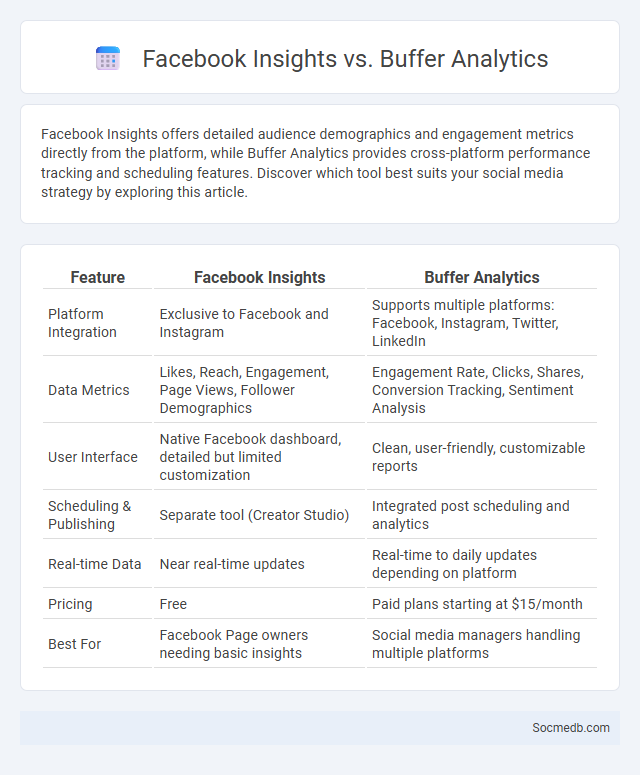
Photo illustration: Facebook Insights vs Buffer Analytics
Facebook Insights offers detailed audience demographics and engagement metrics directly from the platform, while Buffer Analytics provides cross-platform performance tracking and scheduling features. Discover which tool best suits your social media strategy by exploring this article.
Table of Comparison
| Feature | Facebook Insights | Buffer Analytics |
|---|---|---|
| Platform Integration | Exclusive to Facebook and Instagram | Supports multiple platforms: Facebook, Instagram, Twitter, LinkedIn |
| Data Metrics | Likes, Reach, Engagement, Page Views, Follower Demographics | Engagement Rate, Clicks, Shares, Conversion Tracking, Sentiment Analysis |
| User Interface | Native Facebook dashboard, detailed but limited customization | Clean, user-friendly, customizable reports |
| Scheduling & Publishing | Separate tool (Creator Studio) | Integrated post scheduling and analytics |
| Real-time Data | Near real-time updates | Real-time to daily updates depending on platform |
| Pricing | Free | Paid plans starting at $15/month |
| Best For | Facebook Page owners needing basic insights | Social media managers handling multiple platforms |
Overview: Facebook Insights, Buffer Analytics, and Insights
Facebook Insights provides detailed analytics on user engagement, reach, and page performance, offering real-time data to optimize social media strategies. Buffer Analytics measures post effectiveness, audience growth, and peak engagement times across multiple platforms, streamlining content scheduling and performance tracking. Insights from these tools enable marketers to make data-driven decisions, enhancing visibility and interaction on social media channels.
Key Features Comparison
Social media platforms differ significantly in user engagement, content formats, and advertising options, making it crucial to assess each based on your marketing goals. Instagram excels in visual storytelling with features like Stories and Reels, while Twitter prioritizes real-time updates and concise messaging through tweets and threads. Facebook offers extensive community-building tools and detailed audience targeting, whereas LinkedIn specializes in professional networking with advanced B2B outreach capabilities.
User Interface and Ease of Use
A streamlined user interface in social media platforms enhances your experience by offering intuitive navigation and quick access to essential features like messaging, content sharing, and notifications. Clear icons, customizable layouts, and responsive design contribute significantly to ease of use, allowing users to effortlessly engage with the platform across various devices. Prioritizing user-friendly interface elements reduces learning curves and maximizes user satisfaction, boosting overall engagement and retention rates.
Data Accuracy and Real-Time Reporting
Social media platforms rely heavily on data accuracy and real-time reporting to deliver insightful analytics that help you make informed decisions. Accurate data collection ensures that metrics such as engagement rates, follower growth, and click-through rates reflect true audience behavior and trends. Real-time reporting allows brands to monitor campaign performance instantly, enabling swift adjustments to optimize reach and impact.
Supported Platforms and Integrations
Supported platforms for social media include Facebook, Instagram, Twitter, LinkedIn, TikTok, and Pinterest, each offering diverse tools to enhance engagement and brand visibility. Integrations with tools such as Hootsuite, Buffer, and Zapier streamline content scheduling, analytics, and customer interaction, optimizing your social media management workflow. Your ability to connect multiple platforms with CRM and marketing software dramatically improves targeted campaigns and data-driven decision-making.
Customization and Reporting Options
Social media platforms offer extensive customization options, allowing you to tailor content, audience targeting, and ad placements to maximize engagement and reach. Reporting tools provide in-depth analytics, including real-time data on impressions, clicks, conversions, and demographic insights to inform strategic decisions. Leveraging these features enhances campaign performance by aligning content with your audience's preferences and tracking measurable outcomes effectively.
Audience Analytics and Demographics
Audience analytics in social media platforms leverage machine learning algorithms and data mining techniques to provide detailed insights into user behavior, preferences, and engagement patterns. Demographic data such as age, gender, location, income level, and interests are crucial for targeted marketing campaigns, enabling brands to tailor content and advertisements effectively. Advanced analytics tools aggregate user interactions across multiple channels, offering a comprehensive view of audience segments that drives strategic decision-making and improves conversion rates.
Pricing and Subscription Plans
Social media platforms offer a variety of pricing and subscription plans tailored to individual users and businesses, ranging from free basic accounts to premium tiers with enhanced features. Popular platforms like Facebook, Instagram, and LinkedIn provide free access with optional advertising services, while LinkedIn Premium and YouTube Premium offer subscription plans starting around $20 per month for ad-free experiences and advanced tools. Businesses often invest in social media advertising packages or analytics tools, with costs scaling based on reach, engagement, and features such as audience targeting and performance insights.
Pros and Cons of Each Tool
Facebook offers extensive reach and detailed ad targeting, benefiting Your brand awareness and customer engagement, but privacy concerns and algorithm changes can limit organic visibility. Instagram excels in visual storytelling and influencer marketing, driving strong engagement with younger audiences, yet its emphasis on aesthetics may overshadow authentic interactions. Twitter enables real-time communication and trend participation, ideal for customer service and news updates, though its character limits and fast-paced feed can reduce message depth and longevity.
Choosing the Right Analytics Tool for Your Needs
Selecting the ideal social media analytics tool hinges on understanding your specific marketing goals, such as audience engagement, content performance, or competitor analysis. Tools like Sprout Social, Hootsuite, and Google Analytics offer diverse features tailored to various needs, ensuring your data insights lead to effective strategies. Your choice should prioritize ease of use, integration capabilities, and the depth of metrics provided to maximize social media ROI.
 socmedb.com
socmedb.com